| Parts List for the Media Force Field |
|
6 Polygons
1 Light Switch
1 Light
1 Media
1 Sound (electric hum)
|
Refer to the parts list above for what you will need, to make a Media Force Field. You can also Download the demonstration map file to follow along on.
Warning, these force fields only sound good in the texture sets: Lava, and Pfhor. Using one of the others will produce a splashing water sound when a player tries to get through the force field. This sounds really weird, so using a Lava or Goo media is better. The sounds these two medias make is more of a blooop, kind of like bouncing off something flexible.

First, lets make a light.
This light will be used to control the height of the media and a few other things.
Make its active 100.
Inactive 0.
No need to make the light pulsate or anything like that, so don't mess with the secondary attributes.
Make the speed for becomes active and inactive, fast. A period of 10 is good.
Make it initially active too, so the Force Field is on to begin with.
That should do it for the light. Simple light.
You can get real fancy if you wish, and make three different lights, and tagging them together, for the three things that you will want to have all deactivate at the same time. A pulsing light for the light that is on the textures, a slow pulse light for the volume of the transformer, and then a fast deactivating/activating light for the media. These will all be further touched upon later in the demonstration. But for now, stick with this one light.
 |
|
Now, draw out five polygons like you see here. One polygon gets completely surrounded by four polygons. This is imperative, because smearing will occur if the center polygon has any sides as a solid wall (where a texture could be placed). The outer four polygons can be made as thin as possible to reduce the player falling into the crevice where the force field goes (this will be explained in a bit). These five polygons I will now refer to as the Field Box. |
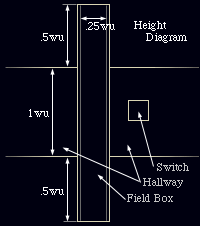 Follow the height diagram to assign heights to the Field Box. The five polygons should all have the exact same floor and ceiling height. Make the floor height at least 0.50wu below the hallway that is being fielded off. Same goes with the ceiling (being 0.50wu above). The reason for this is the media has a nasty tendency to make anything it touches, smear. And since we cannot control the media touching a floor or having a ceiling, it smears these two surfaces badly. Thus that is why we push them down out of view (what the player never sees, will never bother them).
Follow the height diagram to assign heights to the Field Box. The five polygons should all have the exact same floor and ceiling height. Make the floor height at least 0.50wu below the hallway that is being fielded off. Same goes with the ceiling (being 0.50wu above). The reason for this is the media has a nasty tendency to make anything it touches, smear. And since we cannot control the media touching a floor or having a ceiling, it smears these two surfaces badly. Thus that is why we push them down out of view (what the player never sees, will never bother them).
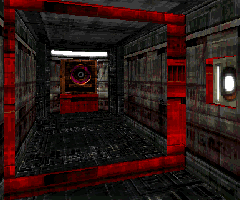 Texture up the Field Box like it's a power surging thingamajig. Use the light you created for the media on the inner walls of the Field Box, and on the switch. This way, when the force field gets turned off, the light will go black as well, showing that no power is surging in the area (a visual cue since the player cannot see the media force field).
Texture up the Field Box like it's a power surging thingamajig. Use the light you created for the media on the inner walls of the Field Box, and on the switch. This way, when the force field gets turned off, the light will go black as well, showing that no power is surging in the area (a visual cue since the player cannot see the media force field).
Place the sound point near this Field Box and have its volume controlled by light. Pick the same light you made for the media. This will then turn off the sound when the force field gets turned off. Just more added effect is all.
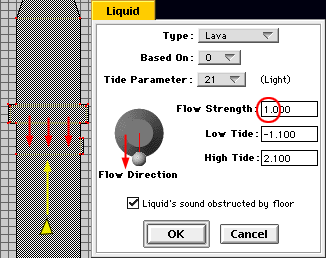
Time to make the media.
Following the dialog to the right, we make the media have the following:
Low tide of -1.100 (below the floor height of the Field Box), there really isn't a reason I made it that number... it was just a nice safe distance below the -0.5wu floor.
High tide of 2.100 (above the ceiling height of the Field Box), same thing about the number like the low tide... no reason, just make it higher than the ceiling.
Flow force of 1.000 (this is extremely fast), Grendel has found that 1.0 is a nice force that will prevent the player from passing through a field that is of a nice 0.25wu width.
Tide parameter of the light we created. This will turn off and on the media force field (using the light switch made on the wall).
Make sure the sound is obstructed by floor. This will prevent the player from hearing bubbling lava when they walk through the turned off Field Box.
Flow direction needs to be going against the direction the player will be comming from. In this example, the player will come from the bottom of the area, and head up (the yellow arrow). The red arrows are the force that will be thrust upon the player if they try to pass or enter the Field Box.
This force field is one way, meaning if you were to stand on the backside when it was on, you would get thrown out into the area that is in front of it. The example map you can Download, allows you to turn on the force field from the backside, and then see for yourself what would happen if you enter the Field Box from the backside.
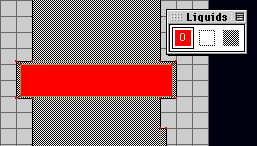
Now place the media in the center box as shown. Only that one polygon, that is surrounded by the four thin ones, should you place the media. Do not place the media anywhere else AT ALL.
That is all that needs to be done. It was a long explanation,
but the steps are really short and simple once you understand them:
Make the light,
Make the polygons,
Set the polygon heights,
Texture everything, and set the light switch,
Make the media,
Place the media,
Put in the sound point,
And go.
How?
(an exhaustive speach)
Media has no textures except for the surface. When you are above it, you see the surface from above, and when you're in it, you see the surface from below. No texture is ever automatically placed on the sides of a media. If you were to make a column of liquid, you would place a pouring like transparent texture on the sides. This texture would then be seen on both sides and you could pass through it into and out of the media.
For the Media Force Field, we do not texture the sides. Thus since media is clear, we can see right through the sides of the media and beyond it. However, when you see the floor of the media polygon from the oustide (looking in past its clear wall), the floor will be smeared (lack of texture), because marathon doesn't know to texture that since you theoretically shouldn't be seeing the floor texture from the outside. That is the whole reason for pushing the floor and ceiling heights beyond vision, so when the player comes up to them, they cannot see the smearing.
This also goes the same for sides that the media touches. Since we surrounded the media polygon with empty polygons, the media would NOT touch a side, and thus it will not cause smearing. That is why we make five polygons, and put the media in the middle.
It will all come clear the more you work with them, and experiment in making new weird things with them.
Grendel is tired now, go away.

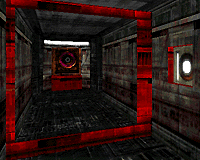



 Follow the height diagram to assign heights to the Field Box. The five polygons should all have the exact same floor and ceiling height. Make the floor height at least 0.50wu below the hallway that is being fielded off. Same goes with the ceiling (being 0.50wu above). The reason for this is the media has a nasty tendency to make anything it touches, smear. And since we cannot control the media touching a floor or having a ceiling, it smears these two surfaces badly. Thus that is why we push them down out of view (what the player never sees, will never bother them).
Follow the height diagram to assign heights to the Field Box. The five polygons should all have the exact same floor and ceiling height. Make the floor height at least 0.50wu below the hallway that is being fielded off. Same goes with the ceiling (being 0.50wu above). The reason for this is the media has a nasty tendency to make anything it touches, smear. And since we cannot control the media touching a floor or having a ceiling, it smears these two surfaces badly. Thus that is why we push them down out of view (what the player never sees, will never bother them). Texture up the Field Box like it's a power surging thingamajig. Use the light you created for the media on the inner walls of the Field Box, and on the switch. This way, when the force field gets turned off, the light will go black as well, showing that no power is surging in the area (a visual cue since the player cannot see the media force field).
Texture up the Field Box like it's a power surging thingamajig. Use the light you created for the media on the inner walls of the Field Box, and on the switch. This way, when the force field gets turned off, the light will go black as well, showing that no power is surging in the area (a visual cue since the player cannot see the media force field).
